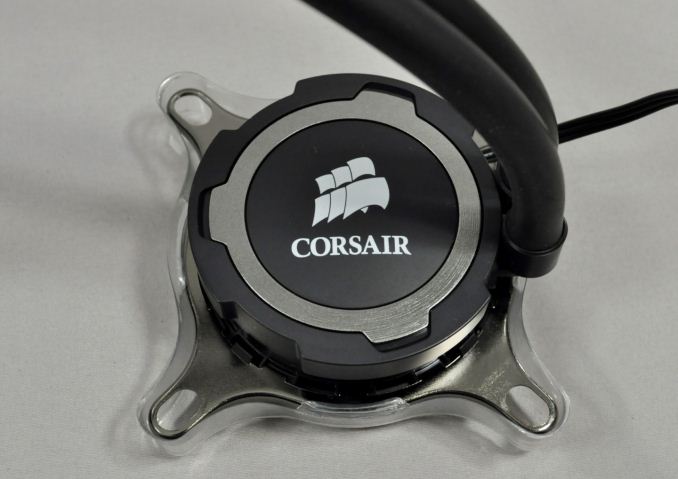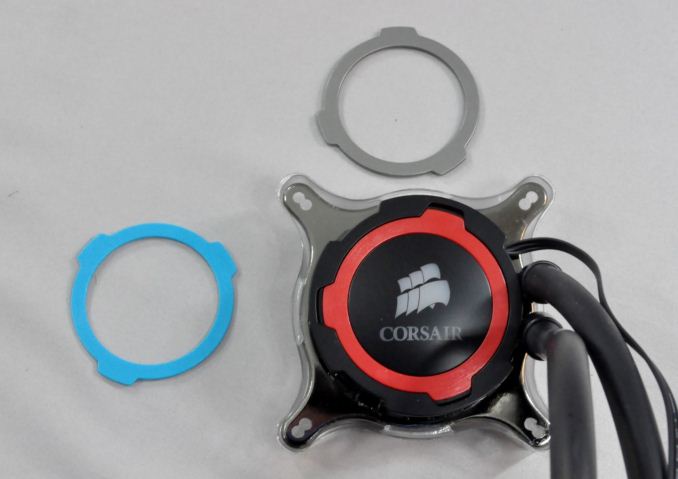Closed Loop AIO Liquid Coolers: 14-way Mega Roundup Review
by E. Fylladitakis on February 12, 2014 7:00 AM ESTCorsair
When we mentioned the word's "liquid coolers" and "roundup" to Corsair, they got a bit overexcited and shipped us five of their AIO coolers. For some reason, Corsair is extremely interested in AIO liquid coolers, which is also reflected by the fact that they are the only company that offers nine such products at this point in time, while most manufacturers are currently limited to just two or three coolers.
Corsair H75
Despite its "small" number, the H75 actually is one of Corsair's most recent designs. We received it supplied in a serious looking, black cardboard box with a blue visual theme. Inside the box, the cooler is protected by cardboard packaging.
Corsair kept the bundle of the H75 down to the very basics: a leaflet with installation instructions and the hardware required for the mounting of the cooler. The bundle is well presented though, with each type of screws/nuts inside a separate nylon bag. Two 120mm fans with grey wide blades are also included in the packaging. The fans have an operating range between 800 and 2000 RPM, which is not very high for wide-bladed 120mm fans.
The Corsair H75 is not a work of art but it does stand out visually. It features a rather small radiator that is only 120mm wide and 25mm deep, which offers no more heat dissipation surface than the radiator of the ultra-cheap Seidon 120V. Even though the radiator is of the same design, this time the aluminum fins are virtually free of imperfections, with very few slight deformations visible. The small size of the radiator gives the H75 an advantage in tight spaces but will certainly have an impact on its overall performance. Corsair also went with kink-resistant, smooth black rubber tubing of normal width, rather than the corrugated tubing many other manufacturers are using.
The block-pump assembly is round, with a silver ring on top and the company logo painted right in the middle of the cap. It also comes with the retention bracket for Intel CPUs preinstalled. The assembly is held together by no less than 20 screws, 12 for the plastic frames and 8 for the copper base. Thermal compound has been applied on the base from the factory. After our testing, we cleaned the base of the cooler, revealing a well-machined and polished surface.
Corsair H105
Announced at this year's CES, the Hydro H105 is Corsair's most recent product. It comes in a large cardboard box similar to that of the H75, yet with a red colored theme, which is the signature of Corsair's "extreme performance" products. The bundle of the H105 is almost identical to that of the H75 as well. Inside the box, we find a leaflet with the installation instructions and the necessary mounting hardware categorized inside nylon bags. However, we also found two colored rings for the CPU block. Finally, even though the wide grey bladed fans are visually similar to those included with the H75, they actually are not similar at all. The SP120L fans supplied with the H105 are much more powerful, with an operational range of 800 to 2700 RPM.
Even though the H105 looks like an oversized version of the H75, there is more to it than first meets the eye. To begin with, the radiator is not only twice as long as that of the H75 but nearly 40% thicker as well, increasing the effective heat dissipation area by well over 150%. Some minor deformations of the aluminum fins are visible this time as well; apparently, the making of such radiators is not an easy process. Although the 120mm width of the radiator makes the H105 compatible with more cases and systems, the length could become a problem, so be especially careful with that.
Similar to the H75, the block-pump assembly is round, with a silver ring on top. The silver ring however is removable and replaceable with either a red or blue ring, now included in the packaging. In addition, the company logo is not painted; on the contrary, it has been left unpainted on purpose and a white LED has been placed beneath it. The bracket for installation on Intel CPUs is once again preinstalled and the cooler has thermal compound applied on its base from the factory floor. Once again, the copper base is well machined and polished, free of imperfections.
























139 Comments
View All Comments
jmke - Wednesday, February 12, 2014 - link
as with everything, the noise scale and extreme focus of SPCR does give a slightly twisted view.none of these AIO would qualify as silent, anything above 30dBA would be loud for him; his kitchen is <30dBA... ;-)
EnzoFX - Wednesday, February 12, 2014 - link
>30DB is loud lol. At least audible to anyone I would say, so can't we at least say it's not silent? Furthermore he'd provide at least a vast array of reference points, where Anandtech is severely lacking when it comes to cooling/cases/etc.E.Fyll - Wednesday, February 12, 2014 - link
Definitely not loud and not even audible to most. 30 dB(A) is the lowermost threshold that the vast majority of sound level meters can take a reading from. I have provided a thorough explanation about this down below in the comments. I personally consider any test that I have seen stating that they got a valid reading below 30 dB(A) with sub - $30k equipment to be rubbish.Jon-R - Wednesday, February 12, 2014 - link
So you're saying that the tests over at SilentPCReview are rubbish? What sound measurement equipment did you use? I couldn't find a mention of it.JlHADJOE - Thursday, February 13, 2014 - link
30 dB is very quiet far as background noise goes.Whisper Quiet Library at 6' 30dB
Sauce: http://www.gcaudio.com/resources/howtos/loudness.h...
JlHADJOE - Friday, February 14, 2014 - link
It's not so much that their tests are rubbish, just unrealistic.SilentPC tests in an anechoic chamber, so the noise floor when they test is near zero. Compared to that, an increase to 30dBA is very loud. But in a real-world environment, 30dBA is whisper quiet.
I do agree though that use of the anechoic chamber keeps their tests consistent and repeatable. Just not necessarily representative of what a case will actually sound like in a real room.
YazX_ - Wednesday, February 12, 2014 - link
Thx for this thorough review, i have corsair H100i, its awesome AIO cooler, but the fans are piece of shit and very noisy, i replaced them with Bitfenix LED ones, although they operate at 1800 RPM, but i never had to see them operate on that speed, my CPU is OCed to 4.5Ghz and max temp is 65, so they work 50% most of the time and pretty silent.AshyPistachios - Wednesday, February 12, 2014 - link
This ended up comparing fans more than it did rads/pumps. I would like to see a test scenario where identical fans are used on each rad. The current testing methodology does test the complete package, but people seeking silent setups tend to swap all of the fans anywayMrSpadge - Wednesday, February 12, 2014 - link
Agreed - comparing performance doesn't mean much with such different fan noise levels. You could use some high pressure fans for all systems, for example.And I couldn't care less if a stock fan runs at 7 V or what ever. What I do care about is the noise. In practice I set my rigs up for the best cooling I can get at subjectively low noise level (they're running 24/7 under load). So pick any reasonably quiet noise level, set the fans to whatever speed is required to get there and then compare performance (note: this is even more meaningful if you use similar fans). With PWM you're not limited to 12V and 7V, it's not 2005 any more.
E.Fyll - Wednesday, February 12, 2014 - link
7 Volts is about the same voltage level as most modern motherboard apply in their "quiet" mode. High enough to start nearly all fans ever made, low enough to keep things quiet. Unfortunately, I cannot perform testing the way you propose. As you mentioned yourself, it would have to be a "subjectively low" noise level. The very word "subjectively" puts me off. Even if I do set such a noise limit, which would be terribly wrong as it would just be based on my subjective opinion, not all coolers would be able to operate as such a noise level at all.It is even less meaningful to use the same fans; when you are buying a kit, you are buying the kit with its fans. Purchasing additional fans not only raises its cost but, depending on the characteristic behavior of the fan, the fan itself can affect performance and favor some kits over others. The actual performance of a fan is not based on its RPM or CFM ratings, it is a very complicated matter. That would render any comparisons between different kits virtually useless. Furthermore, the choice of fans would be based on my subjective opinion as well, nobody warranties that the end user will be purchasing the same fans out of the hundreds of possible choices. Someone would want me to use a quieter fan, others might want something more powerful, others something cheaper, others something fancier and so on. And of course, most would just want to buy a kit and be done with it. The only objective comparison is to compare the performance of a kit with its stock fans, as it comes supplied from the factory. Everything else is based on assumptions and subjective opinions that, including mine, have no place in an objective review.